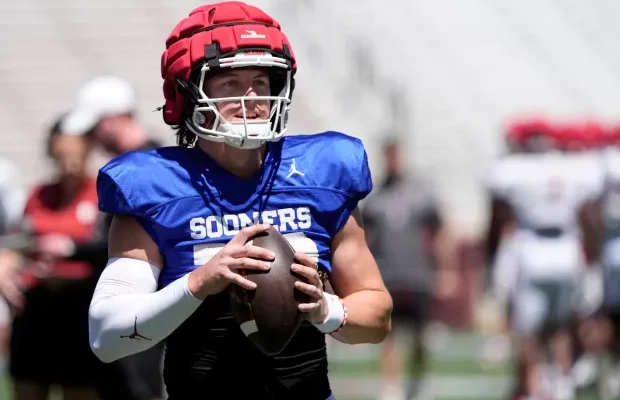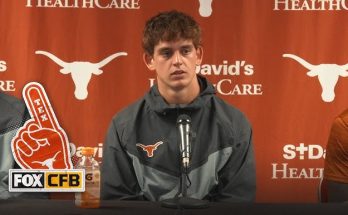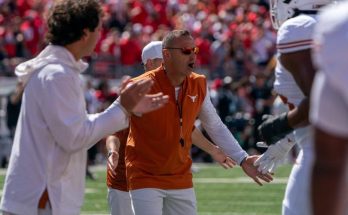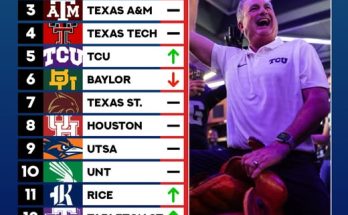There are moments in sports where reputations are forged not just on the field, but in unexpected arenas where ego meets experience and youthful confidence collides with seasoned dominance. One such story has emerged from an unconventional setting involving a former Oklahoma football legend and a young, rising quarterback—John Mateer—who found himself the target of a humbling but unforgettable encounter. This wasn’t a gridiron clash under stadium lights. It wasn’t even a structured workout or football-related drill. It happened far away from where you’d expect two competitive athletes to draw a line in the sand. But make no mistake, the lessons handed out that day were as real and lasting as anything you’d find in the fourth quarter of a rivalry game.
The former Oklahoma legend in question didn’t walk in with a chip on his shoulder, nor did he seek confrontation. But the tone was set the moment John Mateer—brimming with talent, enthusiasm, and perhaps a little too much swagger—started talking. Mateer, a young quarterback with upside and confidence to match, was known for his competitive spirit and wasn’t shy about letting people know when he felt he could hang with the best. The only problem that day? He happened to cross paths with someone who’d been the best—not just locally, not just during his time, but a household name in Oklahoma football lore. A man who had battled under pressure, silenced doubters, and led his team to national relevance. The type of player whose jersey still sold in campus bookstores and whose name could be heard when old fans reminisced about “the good years.”
What makes this story even more compelling is where it all went down: a charity basketball event.
Yes, you read that right.
No pads. No helmets. No roaring crowds calling audibles. Just a hardwood floor, some sneakers, and an event aimed at raising funds for a good cause. The venue might have seemed casual, but to two ultra-competitive athletes, pride was still on the line. And John Mateer, despite being a football guy, fancied himself a hooper. He had the bounce, the handle, and wasn’t shy about calling out matchups. His confidence wasn’t misplaced. In smaller circles and team workouts, he was known for being one of the more athletic quarterbacks—not just able to run an offense but dunk a basketball if the moment allowed. But there’s confidence, and then there’s calling out a legend.
Mateer made it known early that he wanted the smoke. It started with some playful jabs, the kind you might expect at a community event. But as pickup games evolved into more physical contests, with a scoreboard and crowd engagement, Mateer’s words took on a different tone. He challenged the legend one-on-one. It wasn’t malicious—he wasn’t trying to disrespect the man’s accomplishments—but there was an air of youthful invincibility, the belief that the game had passed by the old guard and that new talent was here to redefine the narrative.
The legend didn’t respond with trash talk. He simply smiled. And when it came time for the two to be matched up on opposite sides of the court, the crowd’s chatter turned to cheers and anticipation. What followed was nothing short of a teaching moment—an exhibition of experience, composure, and quiet domination. Every time Mateer tried to drive, he was met with calculated defense. Every shot he put up under pressure fell short. On offense, the former Sooner didn’t rely on flash but fundamentals: pump fakes, footwork, timing. He wasn’t just scoring—he was toying with the younger quarterback.
Mateer, to his credit, kept coming. That’s the thing about real competitors—they don’t fold easily. He adjusted, tried to push the pace, and even managed to get a couple of buckets. But for every highlight he produced, the legend answered twice. There was a moment in the second half of the game where the entire gym fell silent after the Oklahoma icon backed Mateer down, gave a subtle shoulder fake, spun baseline, and delivered a fadeaway jumper with the net barely moving. Mateer’s expression said it all—not frustration, but recognition. He was in the presence of someone who hadn’t just played at a high level but had internalized what greatness looked like.
But the real story isn’t about who won the game. It’s about what happened afterward.
Following the event, both athletes were seen laughing and talking on the sidelines. Mateer approached the former legend with humility, clearly aware that what he’d just experienced was something more meaningful than a pickup game. He wasn’t just schooled—he was mentored. The older athlete didn’t gloat. He didn’t remind Mateer of the score or the buckets. Instead, he pulled the young quarterback aside and talked about what it really means to carry yourself like a competitor. He talked about silence over shouting, composure over chaos, substance over spectacle.
It was a transfer of knowledge that had nothing to do with football technique or basketball drills. It was about mindset. Maturity. The ability to compete without letting ego drive the bus. And in many ways, it was a microcosm of what makes sports beautiful—the passing of the torch, not when the younger beats the older, but when the younger learns how to become the older.
That night, Mateer may have walked in thinking he was going to make headlines, but he walked out with something far more valuable—respect, perspective, and maybe a little reminder that talent is just the beginning of the journey.
The story caught fire across Oklahoma’s athletic community. Social media lit up with playful banter and subtle references to the matchup. A few videos even leaked of the contest, sparking commentary from former players, fans, and analysts who delighted in seeing the legend’s smooth footwork still intact after all these years. But more importantly, the story served as a reminder of how much ground separates promise from polish. It doesn’t matter how fast you can run a 40-yard dash or how tight your spiral is in a workout. Until you’ve been tested by someone who’s walked through the fire, your skill is still waiting to be proven.
For Mateer, the takeaway was significant. In interviews afterward, he mentioned the encounter not as a loss but as a lesson. He acknowledged that he had underestimated just how much wisdom lives in the bodies of aging athletes—people who might not move as fast or jump as high but know the angles, the timing, the psychology of competition. And it’s that mental game, more than raw athleticism, that often separates good from great.
The former Oklahoma legend, true to form, brushed off the attention. He’s never been one to seek cameras or headlines. But those who know him understood exactly what happened: he protected the integrity of competition. He reminded everyone that pedigree is earned. That mouth doesn’t move the scoreboard. That you don’t talk your way into greatness—you grind your way in, and sometimes you have to be humbled before you fully grasp what greatness even looks like.
It’s possible that Mateer, years from now, will become a legend in his own right. He’s got the tools. He’s got the drive. And if that night left a lasting mark, as many believe it did, he’ll carry forward more than just a memory. He’ll carry a blueprint. One drawn not in a classroom or a coaching seminar but on a hardwood floor during a charity event where egos were checked, lessons were learned, and the torch—if not passed—was at least acknowledged.
Every generation needs its defining moments. For some, it’s a game-winning touchdown or a season-defining comeback. For others, it’s a humbling afternoon against a player who’s been there, done that, and doesn’t need to prove anything anymore. What happened between the Oklahoma legend and John Mateer wasn’t just an encounter—it was a rite of passage. One that will linger in stories, locker rooms, and late-night workout conversations for years to come.
And that’s what sports are all about—not just wins and losses, but the stories that teach us who we are, where we stand, and what it takes to become something more.



